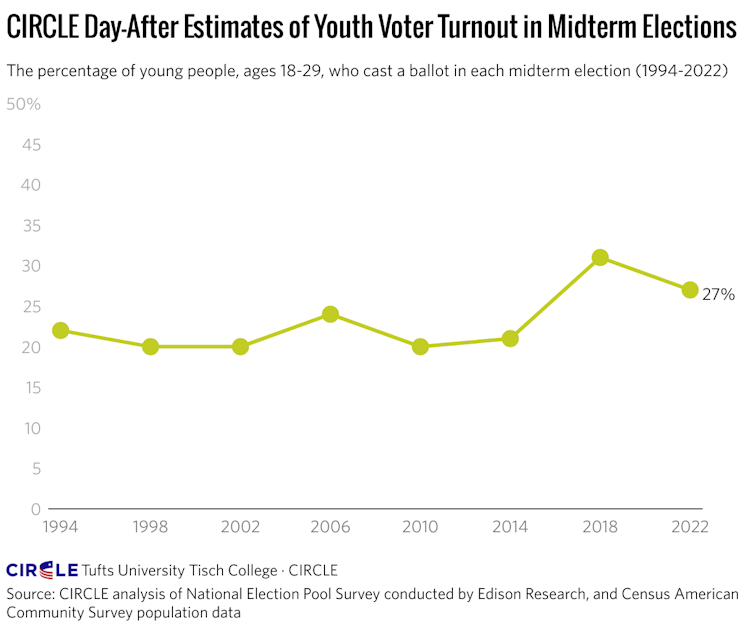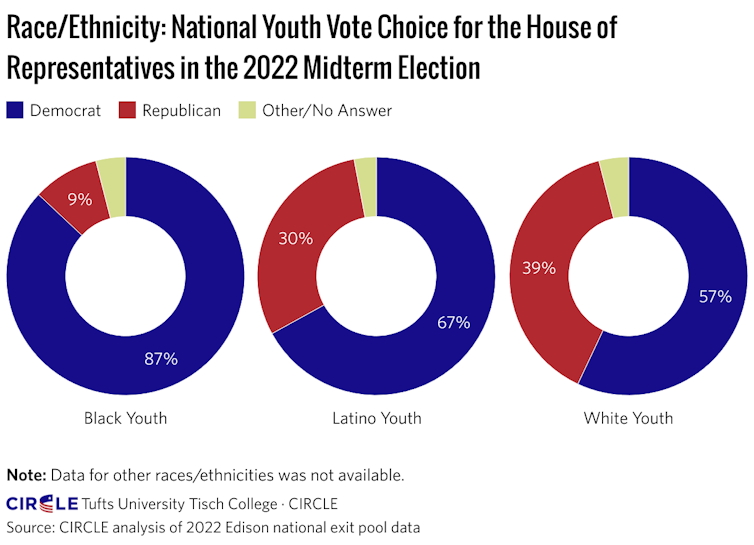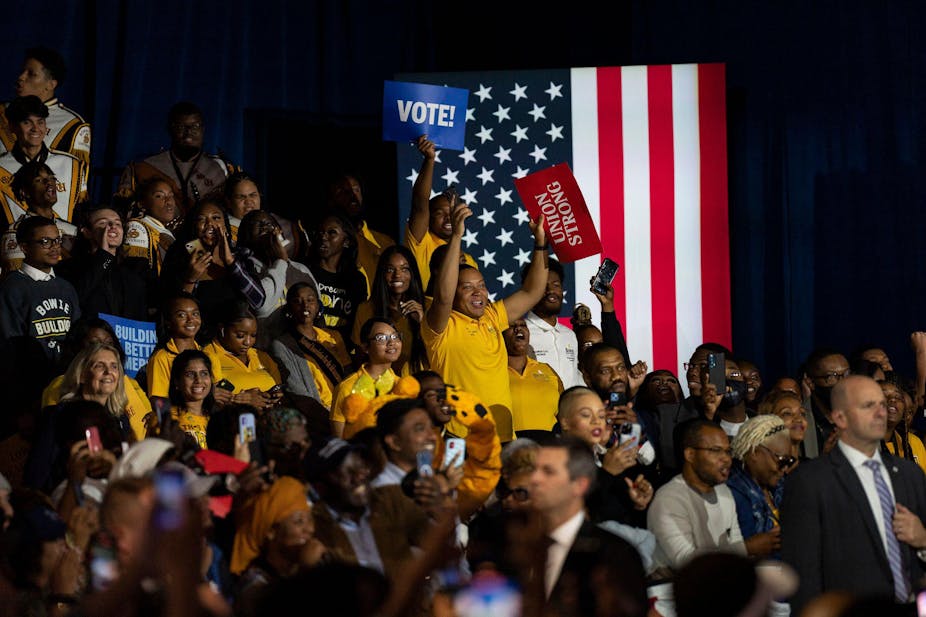An exceptionally high turnout of young voters swung key state battles in favour of the Democrats in the 2022 US midterms. It’s estimated that more than a quarter of registered voters aged between 18 and 29 years of age cast a ballot in elections that saw the Democrats maintain control of the Senate and minimise Republican gains in the House of Representatives.
President Joe Biden thanked “the young people of this nation” for turning out in what he called “historic numbers”. Exit poll data has indicated that 27% of young people voted, the second highest percentage in in the last thirty years, beaten only by the record of 31% set during the 2018 midterms.
Exit poll analysis by the Center for Information and Research on Civic Learning and Engagement at Tufts University, known as Circle, indicates that youth voter turnout was particularly high in battleground states such as Florida, Georgia, Michigan, North Carolina, New Hampshire, Nevada, Ohio, Pennsylvania and Wisconsin.
In Arizona, Democrat Katie Hobbs won her governor’s race by 20,000 votes, with around 60,000 more young people voting for Hobbs than her rival Kari Lake. While in Wisconsin, 79,000 more young voters chose Democratic governor Tony Evers and contributed towards his victory of 89,000 votes – 88% of the margin of his victory – over Republican candidate Tim Michels.
‘They’re voting more’
The turnout was an illustration that this is the most politically engaged cohort of youth voters in recent history. Ruby Belle Booth, Circle’s elections coordinator, told US radio station NPR the 2022 midterms represented “high civic engagement” among younger voters.
This assessment was echoed by Cristina Tzintzún Ramirez, president of NextGen, a youth advocacy non-profit and political action committee, said: “They’re voting more. They’re participating in protests. They are more avid readers of politics and social issues.”

And when young voters did reach the polls they voted overwhelmingly for Democrat candidates across the country. According to reports, 63% of 18- to 29- year olds voted Democrat and 35% voted Republican in the House of Representatives elections. Voters between 30 and 44 split their vote between the two parties, while older voters tended to vote Republican.
Young black and Latino voters went Democrat
Exit polls also showed that ethnicity also played a key part in determining who to vote for. Black young people voted almost unanimously for the Democrats, while 67% of Latinos in this age group also chose them over the Republicans. This has added significance when read alongside the number of newly eligible young voters for the 2022 elections: 2 million are Latino and 1.2 million are black out of a total of 8 million new voters.
Despite having a number of Latino Republican candidates across the country, the expectation that Latino voters would move to the right did not occur among young people. There was some evidence of this among older voters although it varies state by state.

In Texas, 53% of those aged 65 and over voted Democrat, while in Florida 64% voted Republican. In both states, however, those aged 18-29 preferred Democrat candidates: 56% in Florida and 76% in Texas. There is not a single trend for Latino voters, but experts say that this is consistent with historic Hispanic voting patterns.
Abortion rights a key issue
While climate change and gun violence have been cited as key concerns for young voters, some researchers believe it was the issue of abortion rights that to have led to many voters casting a ballot this time round.
The supreme court’s decided earlier this year to overturn the historic 1973 Roe v Wade ruling and the constitutional right to abortion it created. Exit poll data concerning the issues illustrate that this decision has prompted young voters to take to the polls, and they were the only age group to cite abortion as the major issue.

In addition to the congressional elections, reports show that young voters turned out in large numbers to vote in state-wide referendum on abortion rights, minimum wage rates and voting rights. This may have contributed towards the failure of the forecast red wave of Republican victories to materialise.
Democrats courted the young
Another reason for such a high turnout among young voters could be the significant activity and record investment in key states by Democrats.
In Pennsylvania, Democrats gained votes in the suburbs and outperformed Biden’s 2020 campaign, particularly in rural areas. According to Ramirez, engaging with 2.1 million youth voters in the state helped create Democratic Senate candidate John Fetterman’s surprise victory over television personality Dr Oz.
Read more: A Republican bubble? How pollsters and pundits got the US midterms so wrong
Speculation remains as to what extent Biden’s cancelling of student debt had in voter support for the Democrats. It may have helped but this is unclear.
Future support may be influenced by the Donald Trump-appointed US district judge in Texas, Mark Pittman, who declared the programme illegal, bringing the programme to a nationwide standstill. It may take months for the supreme court to decide on the Biden administration’s appeal on the ruling.
A generational shift?
John Della Volpe, director of polling at Harvard Kennedy School’s Institute of Politics, argues that gen Z voters have emerged as an influential and active voting bloc. The Democrats, he believes, would do well to seek the vote of the 18–29 voters as “Gen Z and Millennial voters will account for nearly 40% of votes” at the 2024 election.
Democratic Representative Alexandria Ocasio Cortez agrees with Volpe’s assessment. She arguies that the US is beginning to see result of what she calls a “generational shift” in American politics.
If the current trend in youth voter turnout persists, the 2024 election victory might be decided by their support. Republican stalwarts’ criticism of Democrats attempts to woo young voters, such as that of Senator Ted Cruz, has done nothing but indicate they are out of touch with the gen Z-millennial bloc.
Democrats hold a clear advantage with the young voters of today and that could prove to be significant, not just to their election chances in 2024, but also as influence on the Democratic party.

